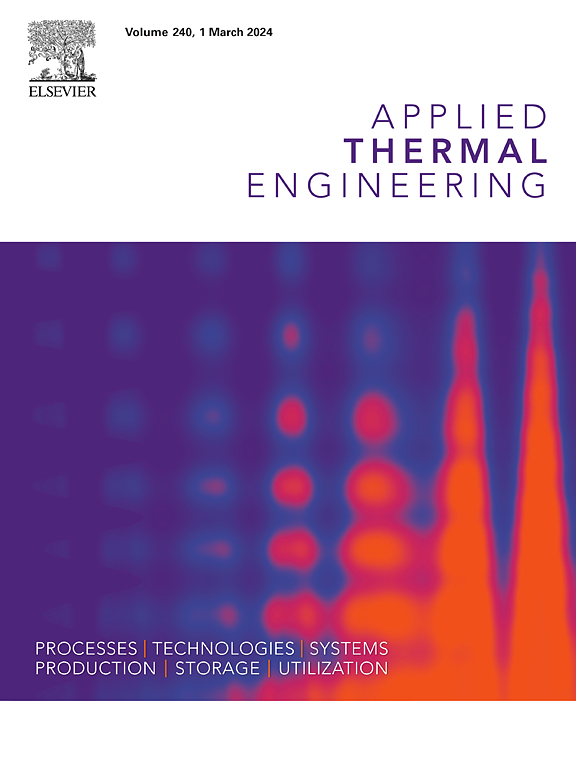CFD and Machine learning-based predictive modeling of natural convection in non-Newtonian nano-encapsulated phase change material within an Enclosure with a corrugated heated cylinder
IF 6.9
2区 工程技术
Q2 ENERGY & FUELS
引用次数: 0
Abstract
Enhancing heat transfer and energy storage presents challenges in renewable energy applications. This study examines the thermal efficiency of power-law non-Newtonian nano-encapsulated phase change materials (NEPCM) in a cavity with a corrugated cylinder under natural convection. A non-dimensional framework was developed using the Galerkin finite element method (GFEM), with Polyethylene Glycol (PEG) as the base fluid. Machine learning-based predictive modeling was integrated with computational fluid dynamics (CFD) framework to provide a more reliable approach. The study numerically examined the effect of different non-dimensional parameters, including Rayleigh number , Hartmann number , power-law index , Prandtl number , Stefan number , and fusion temperature . It examines streamline, isotherm, entropy generation, heat capacity ratio , Nusselt number , and Bejan number . Five machine learning models-Decision Tree, Random Forest, KNN, XGBoost, and LightGBM-were used to predict fluid behavior. Results show that increasing reduces vortices, bringing NEPCM’s heat transient phase closer to the cylinder. Higher shrinks the melting region, and peaks at , decreasing with higher due to the magnetic field. At , drops by 65.88% in the shear-thinning phase . Additionally, is reduced by 17.35% as the fluid transitions from the shear-thinning phase to the shear-thickening phase . The power-law index increases . Random Forest achieved the highest (0.9959) for , while Decision Tree, Random Forest, and LightGBM showed superior accuracy for . These ML models guarantee quick and precise predictions and act as a roadmap for following fluid dynamics and thermal management research. The interdisciplinary nature of the study, combining GFEM, NEPCM, power-law fluids, and several machine learning models, establishes a benchmark for advancing computational and data-driven approaches to solving challenging engineering problems.

基于CFD和机器学习的非牛顿纳米封装相变材料在波纹加热圆柱体内自然对流预测建模
加强传热和能量储存是可再生能源应用的挑战。本研究考察了幂律非牛顿纳米封装相变材料(NEPCM)在自然对流条件下在波纹圆柱腔中的热效率。采用Galerkin有限元法(GFEM),以聚乙二醇(PEG)为基液,建立了一个无量纲框架。基于机器学习的预测建模与计算流体动力学(CFD)框架相结合,提供了更可靠的方法。数值研究了Rayleigh数(Ra=104 ~ 106)、Hartmann数(Ha=0 ~ 90)、幂律指数(n=0.7 ~ 1.4)、Prandtl数(Pr=200)、Stefan数(Ste=0.313)和熔合温度(θf=0.3 ~ 0.8)等不同无因次参数的影响。它检查流线,等温线,熵生成,热容比(Cr),努塞尔数(Nu)和贝让数(Be¯)。五种机器学习模型——决策树、随机森林、KNN、XGBoost和lightgbm——被用来预测流体行为。结果表明,Ra的增加使涡流减小,使NEPCM的热瞬态相更接近圆柱体。θf越高,熔化区域越小,Nu在Ra=106处达到峰值,随着Ha的增加而减小。在Ha=90时,Nu¯在剪切减薄阶段下降了65.88% (n=0.7)。随着流体从剪切减薄阶段(n=0.7)过渡到剪切增厚阶段(n=1.4), Nu¯降低了17.35%。幂律指数增加了Be¯。Random Forest在Nu¯上的R2最高(0.9959),而Decision Tree、Random Forest和LightGBM在Be¯上的准确率更高。这些机器学习模型保证了快速和精确的预测,并作为后续流体动力学和热管理研究的路线图。该研究的跨学科性质,结合了GFEM、NEPCM、幂律流体和几种机器学习模型,为推进计算和数据驱动方法解决具有挑战性的工程问题建立了一个基准。
本文章由计算机程序翻译,如有差异,请以英文原文为准。
求助全文
约1分钟内获得全文
求助全文
来源期刊

Applied Thermal Engineering
工程技术-工程:机械
CiteScore
11.30
自引率
15.60%
发文量
1474
审稿时长
57 days
期刊介绍:
Applied Thermal Engineering disseminates novel research related to the design, development and demonstration of components, devices, equipment, technologies and systems involving thermal processes for the production, storage, utilization and conservation of energy, with a focus on engineering application.
The journal publishes high-quality and high-impact Original Research Articles, Review Articles, Short Communications and Letters to the Editor on cutting-edge innovations in research, and recent advances or issues of interest to the thermal engineering community.
 求助内容:
求助内容: 应助结果提醒方式:
应助结果提醒方式:


